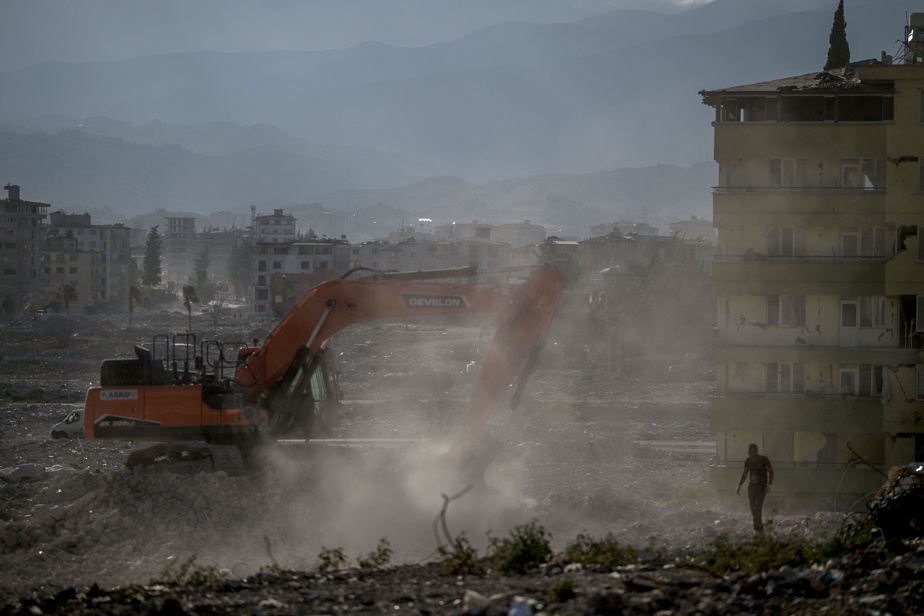(Samandağ) The jaws of the excavator attack the gaping structure of the building to tear off the last sections still standing, which crash into a cloud of dust.
“They don’t even water! “, protests Cagdas Can, 33, environmental activist from the Yeniden Insa (Rebuild) platform, observing the movements of the trucks leaving the center of Samandag towards the huge open dump, adjoining one of the longest Turkey beaches.
Located in the extreme south of the province of Hatay, the most affected by the earthquake of February 6 which devastated the south of the country and Syria, killing more than 55,000 people, the coastal city of Samandag lives in a cocoon of fine gray powder that drowns the horizon.
Five months after the disaster the construction site is colossal. The Turkish government has counted nearly 2.6 million buildings destroyed.

PHOTO OZAN KOSE, AGENCE FRANCE-PRESSE
Excavators work on a landfill near a beach in Samandag.
According to the United Nations Environment Program (UNEP), 116 to 210 million tons of rubble must be evacuated – the Ground Zero site in New York, after the collapse of the World Trade Center on September 11, 2001, accumulated 1 .8 million tons.
In this province bordering Syria, many landfills have been opened: that of Samandag, a monstrous greyish pachyderm swept by the sea winds, adjoins the Mediterranean and the natural bird reserve of Milleyha, a nesting site for Caretta Caretta turtles and green turtles Chelonia Mydas, classified as endangered species.
Irons and metals
“There were other possible sites… But the private companies that won the tenders (for clearing) come here to save fuel,” accuses Cagdas Can.
“For them, all that matters is recovering iron and metals,” he says, recalling how much these construction machines had failed in the first days of the disaster.
With his association, they “formed human chains to block the passage of trucks. But the gendarmes intervened, eighteen people were arrested. I had my collarbone broken”.
“Nobody wears a mask. The demolition sites are not tarpaulined, not watered, nor are the dumpsters of the trucks, as the legislation requires, ”notes the activist.
The population, weary, has ceased to mobilize, he regrets. Yet she worries just as much as conservationists and doctors about the lack of precautions.
“Children are the first affected, they cough a lot, so do we. As soon as it’s windy, everything is covered in dust,” notes Mithat Hoça, 64, who watches his market stall in the center of Samandag.
“We have to put everything under cover,” confirms Mehmet Yazici, a 61-year-old retiree who passes by on a scooter. “We wipe the table 15 to 20 times a day. You have to do it every half hour.
“We survived the earthquake, but this dust will kill us,” sighs Michel Atik, founder and president of the Samandag Environmental Protection Association. “We are going to die of respiratory diseases and lung cancer with all these hazardous materials”.
Asbestos and lead
Installed in the small white container which serves as his clinic in the center of Antakya, 26 km from Samandag, the Dr Ali Kanatli is already seeing “conjunctivitis, allergic outbreaks, asthma, bronchitis” scroll by…
But, above all, it is the hazardous materials contained in the rubble scattered by the dust and the long-term health consequences, including an outbreak of cancers, which concern the Dr Kanatli, representative of the Association of Doctors of Turkey in the province of Hatay.
Turkey did not ban asbestos until late, in 2013, he recalls, and most of the buildings affected are older.
“In addition to asbestos, there is lead in paint, heavy metals, including mercury in electronic equipment such as televisions, household appliances…”, he lists.
The doctor points to another problematic dump in the northeast of Antakya, a valley of olive trees at the foot of the Nur mountains that dominate the city.
With nearly 17 million olive trees (in 2021, according to the Hatay Chamber of Agriculture), olive oil was the province’s primary source of income.
